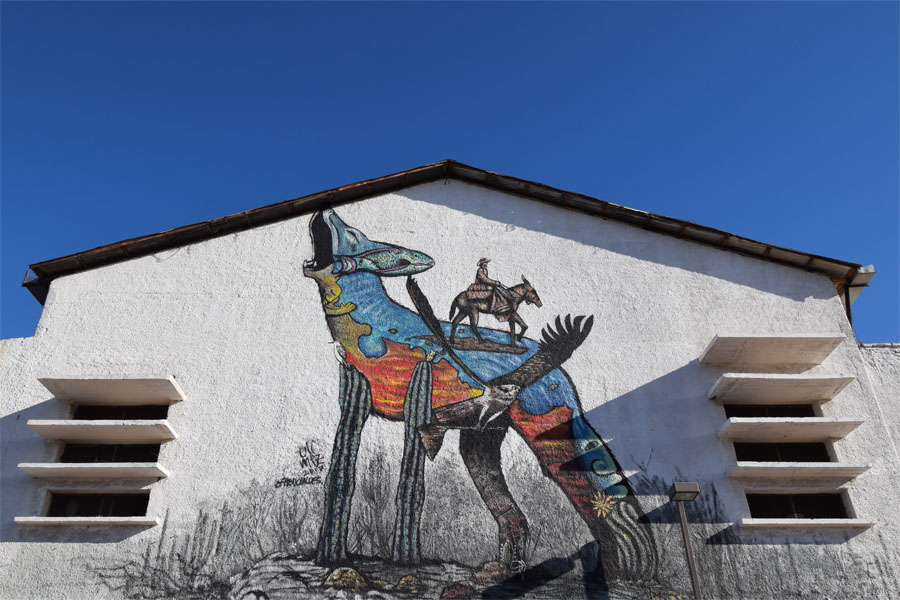

Sailing down the Baja peninsula, we have seen many places relatively untouched by civilization. Dips in the coastline where wind and waves take a break and boats and their crew can find some rest, surrounded by silent stars and rocks standing as witnesses to the passage of time. Fishing villages only as big as utility requires them to be, and towns where the necessities of life are simple make up most of our experience of society as we have seen so far. Standing in contrast are towns such as Cabo San Lucas, which have grown up quickly, swelled by the income of tourist cash, but without the depth and stability of a genuine settlement. La Paz then is an exception among the towns of Baja California Sur; the capital of the state, with most services and conveniences that you could need, including airports, bus centers, and a whole slew of marinas to choose from.

Despite La Paz being a extensively developed town, one of the main attractions of the area is a shallow bay in front of sand dunes where adolescent whale sharks come to feed on krill. Growing up to 41.5 feet in length (some eyewitness accounts describe 60 foot individuals), whale sharks are biggest species of fish in the world. Although they are technically sharks, these gentle giants are filter feeders, so it is safe to get in the water with them. Being a conservation minded state, swimmers are limited to only 5 per group and must be guided by certified ecotourism guides. Swimmers are not allowed to touch the sharks, and must stay 4 feet away from them, although that is more out of concern for the swimmer being hit by a shark with poor peripheral vision. On a calm morning, we followed our Mexplore tour group out in a covered panga to the feeding zone for a swim. As we donned our wetsuits and snorkels, our guide Francisca; a PhD marine biology student from Italy, gave us a brief introduction to the behemoths that we were about to encounter. Whale sharks float near the surface of the water grazing on krill and small fish, casting a dark silhouette that is a telltale sign of their presence. Our group would be divided into 2 teams and take turns jumping into the water; Travis and I took turns staying in the boat with Rowan, where he could watch dry and safely from the deck of the panga, contently munching on crackers.

After searching for a few minutes, we spotted a whale shark, and our first team jumped into the water. We quickly found out how fast whale sharks can disappear into the murkiness of the water, swimming away or diving deep so that we could not catch up, and had to return to the panga for another try. A few minutes later, we spotted another whale shark, and our second team now knew to jump in and chase the whale shark without any hesitation. They were treated to a sight of the whale shark feeding feet away from them, opening its cavernous mouth to gulp down krill. The adolescents that we encountered were only about 15 feet in length, but up close that was more than enough whale shark for some children in our group, and even some adults, who then were happy to stay on the panga the rest of the day. Over the next 2 hours, all of us got to take multiple swims with the sharks, frantically flipping our fins alongside them as they placidly moved thru the water with seemingly no effort at all. Returning to the harbor at midday, we were greeted by a huge pod of bottle nosed dolphins, the icing on our day of nature encounters.

Making La Paz our home base for awhile while we enjoyed the regularity of being stationary, we got to see many things that make interesting walks around the town. On the Malecon waterfront walkway, Rowan got to play on beach swing sets as we enjoyed the ocean view and ate ice cream in local flavors such as custard apple and passion fruit. In the farmer’s market, we got to see the hippie side of La Paz as we browsed organic produce, handmade toiletries and craft works. At the Catedral de Nuestra Senora de La Paz, we got to appreciate the neoclassical architecture and elaborate altarpieces of the building. At the Museum of Anthropology, we saw the work of contemporary photographers complementing regular exhibits featuring Stone Age findings of the area, history of the missionary era, and more recent political history. With our rudimentary Spanish, we did the best we could to understand signs that went with the items on display, but we have a long way to go to fully enjoy museums.



Anchored in the La Paz channel, we were in close proximity to Club Cruceros, a cruisers’ club made up mainly of Americans, that organize a cruiser’s radio net and coffee time every morning, and support children from impoverished families by running charity events and encouraging donations. Our convenient location however, comes with an unfortunate circumstance. In most situations, uniform wind and current direction means that boats in the same anchorage end up pointing in the same direction and maintain the same distance between each other. Here however, switching tides in the channel result in what is known as the La Paz Waltz, where boats anchored out end up pointing in different directions, potentially hitting each other if they are not anchored far enough apart. And with the constant swinging, boats anchored for more than a week become susceptible to tripping their own anchors up by wrapping their chain around their flukes, and drifting away. Which is what happened to Monsoon one windy day, a lesson well learned and not to be forgotten. We escaped a lee shore by only a few feet, luckily without any damage or injury, and headed into a marina to lick our psychological wounds.



Including time spent with Monsoon docked in a marina while we returned to Ohio for Christmas, we have been in La Paz for 2 months now. Being on land for so long has given us a fresh perspective and appreciation of our ability to sail away to new destinations, and we are itching to stretch our sails. In the coming weeks, we will be weather watching for days when the dreaded and ironic cruising season Northers are not blowing, and heading up the Sea of Cortez over areas of national marine sanctuaries, deserted islands boasting a great abundance of sea life, and what is generally agreed to be the best cruising grounds of the Sea of Cortez.


Guys, love your progress, we’ll be there next year this time. Even San Diego is cold and rainy now-
Chad
LikeLiked by 1 person